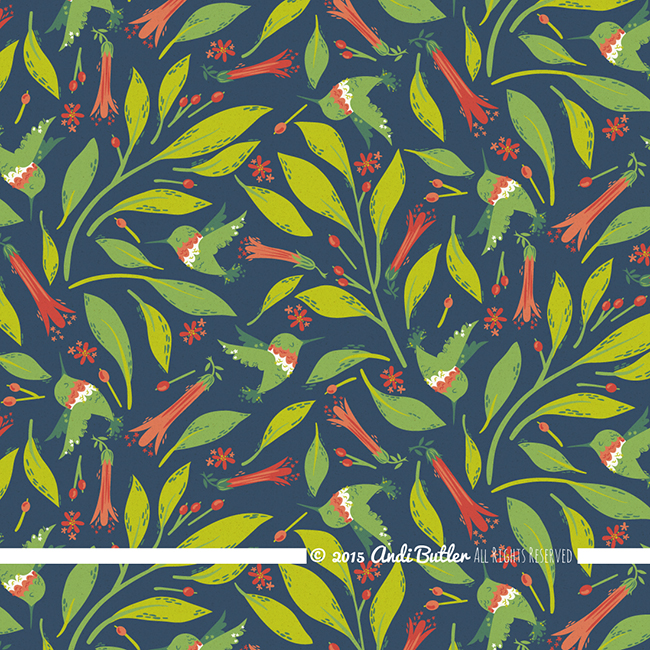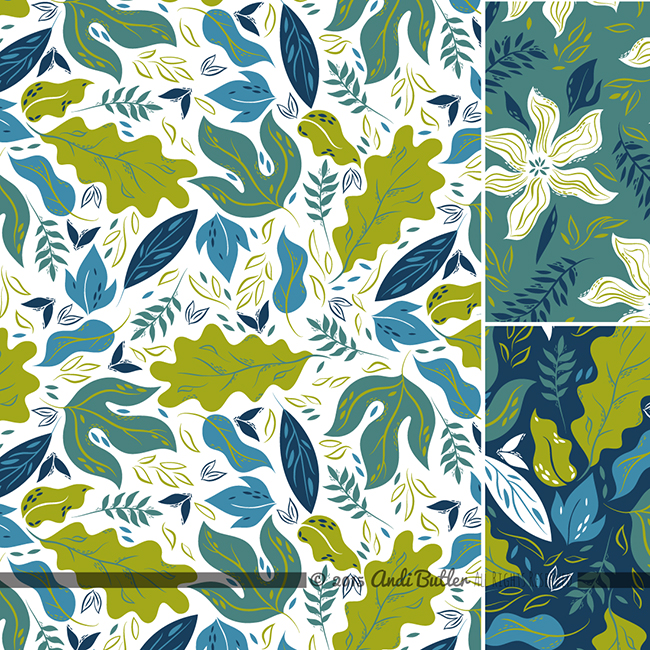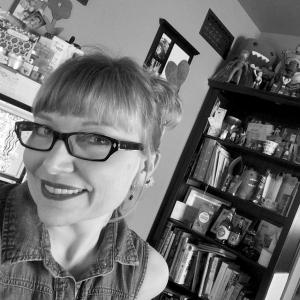My name is Andi Butler, I’m a Surface Designer, and I’m also an Illustrative Designer, a term coined by Von Glitschka to take the title of Illustrator a little farther. Not all illustrators are designers, and not all designers are illustrators, but there are many of us who do both. I started my career as an Assistant Designer in Children’s Product Development for a major retailer in the early nineties. After moving up to a Staff Artist, taking the leap as an Indie Creative, back as a corporate Senior CADesigner, I, again, became an Independent, and have been since 2002. I’ve created for apparel, product development, social expressions and publishing with companies like Klutz, Wilton, Fisher Price, Highlights for Children, Hallmark, Peaceable Kingdom, Kmart and Sears.
What inspired you to become an artist?
My parents made me a creative. My mom is a maker. She was born in England during WWII, and after the war, Europe had nothing. She was a maker then, and when she wanted or needed something she would make it with whatever was on hand: old sweaters, blankets, restyle an old coat. My gran taught her to sew, and she taught me when I was nine. I was always creating things out of fabric, paper mach?, starched string, beads, cakes, anything tactile. I wanted to be a costume designer so badly (I also wanted to be an entomologist). My dad is a realist. He made sure that I had “something to fall back on, like typing” when I was young. He really wanted me to have a good work ethic. But he’s also a collector, and that made him an amazing organizer: 45s, baseball cards, screws, nails, batteries, cancelled stamps. He grew up during the war as well, from a family of six kids. He had huge drive and a competitive streak. He spearheaded many projects as a young person, from school theater to racing pigeons, and never asked permission. He always knew what he was going to do and he just did it. Growing up this way, I was destined to have some type of creative career.



What tools do you use to organize your work?
I’m a Gen X’er, so digital media was just entering colleges and companies for creative means in the early nineties. I used gouache, colored pencil, ink, graphite, charcoal and marker all through college but when I became an assistant designer, we started using Photoshop to scan our motifs to put them in a repeat. We also used Aldus Freehand and Monarch Knitting and Weaving Systems (a life-saver, we would paint or marker render plaids by hand, and send them out to have them repainted if we needed recolors)! I started using Adobe Illustrator in 1997, and InDesign shortly after that. Since then I’ve used U4ia (that was a PC, raster repeat program), and other stand alone repeat programs. But today, I stick with Illustrator and a little Photoshop. I work on a MacBook Pro, with an external monitor and Intuos Pro. I also have created a little on the iPad, but I’m not super comfortable with it. I am getting back to my roots with some pencil sketching and gouache. There’s something needful about having that organic media. The smell of it, the pressure on the pen or brush, and just the whole process of using it, that adds to the life of the work. I’ve just started using brush pens, I love them! I also have one small set of Copics that I’ve been monkeying with. I love my digital work and would never give it up, but it is still too easy to fix the mistakes, I miss them. I consider social media a valuable tool as well, but you can have too much. I focus on Twitter, Instagram and a little on LinkedIn. One of my goals this year was to spend more time updating my blog and website. I think we’ll see more artists going back to them, as these social media outlets get more overwhelming and more about the “likes” rather than the content.
What is your ideal work environment?
I love my workspace. Part of the reason I have it is because I needed a studio and a workroom, and, part of it was because my husband didn’t want to buy the same furniture twice. My studio is what would’ve been our living room, and my workroom is what was our dining room. I have a lot of windows, and it’s exposed on three sides, missing only the western exposure. If I had to pick one thing to add, I would love sky lighting! Both spaces are painted blue. It was called Denim, but it’s more like a cross between a Robin’s Egg and a Wedgwood or Blue Hydrangea. Naturally, it absorbs the light coming in, so it drifts between those hues. I have a drawing table with a recessed lightbox and a whole mess of books…
Where does your design inspiration come from?
I wish I could spend all my time outside. I get out when I can, and spend that time photographing what surrounds me. I do have a Pinterest account, and love the diversity in the work of others that I pin. I listen to our local NPR station constantly. The stories you can hear in just a day, really propel me. I actually get a lot of inspiration from the time of year, and cooking pubs, primarily magazines. There’s a lot of atmo(sphere) and really gets me motivated, which is what it’s supposed to do. It’s fresh and interesting and makes it easy to fill my swipes library. Speaking of that, I have both a huge digital and tangible swipes library. I save every greeting card, interesting packaging, stickers, buttons, pins. I pick up little bits of things, collect pieces of stuff, photos of leaves and bugs, and everything goes in the swipes bins. Lastly, I have a lot of books: picture books, non-fiction, activity, and reference that cover all sorts of subjects, from Camping to Typography. All of these things are more about the feelings I get when I go through them, rather than referencing styles or techniques.
Who are the creative people you admire most?
There are creative people whose work I love, like Charley Harper, Angie Lewin, Jim Flora, Naiad and Walter Einsel, Shaun Tan, Louise Fili, John Hendrix, Steve Simpson, and Scott Campbell. Then there are problem solvers who I greatly admire. They think creatively but aren’t necessarily visual artists in a literal sense. One of them, Amy Poehler, is an insightful actor and writer, and is making such a difference in girls’ lives with her Smart Girls Organization. Jim Henson was so innovative, and has done so much for children’s education. He brought diversity into my world, and helped me feel connected. Ira Glass is an amazing storyteller, and is the creator, contributor and host of This American Life. He knew there were so many stories out there that needed to be heard. The stories you don’t hear on mainstream news, not from rich people, not celebrity weddings. Just people like the rest of us, with all kinds of stories. To tell stories well, you have to really listen too. So listening to the podcast, or This American Life is broadcast on our local NPR station, makes me a better listener, observer, and, storyteller in my illustrations, or even in my surface design. I want them to invoke warmth and goodness when people see them. That’s what makes me feel that I’m successful, more than anything else. : )
